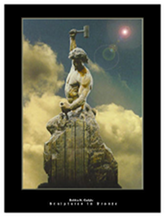



Thomas Jefferson - New! 
Self Made Man Poster 
Self Made Woman Poster 
Schedule of Events 
|

You first need to create an original clay model of the sculpture to be made into bronze. The clay model must contain all of the details that the sculptor wants in the finished piece. Care must be taken to capture the smallest of detail. The mold is then cut, depending on the size of the sculpture, into separate sections for casting. Molten wax is then poured into the mold. This is done by pouring in layers until the desired thickeness of the finished piece is obtained. The wax model is an exact duplicate of the original casting. Channels, made up of wax rods, are added to the model to insure the metal is evenly distributed in the casting. The mold is then placed in a pit of sand or similar material to steady it for pouring. Then molten bronze is poured into the mold, the liquid metal melts and replaces the wax model. Hence the name "lost wax". The metal then cools and hardens, forming an identical sculpture in bronze. The piece is then finished by hand. This is where the work really starts. The channels must be cut off. The parts are welded together, ground, polished and buffed. Many of the finished pieces are then given a rich, gray-green patina called "verdigris" to help protect the brass and add to its appeal by giving it an aged look. |